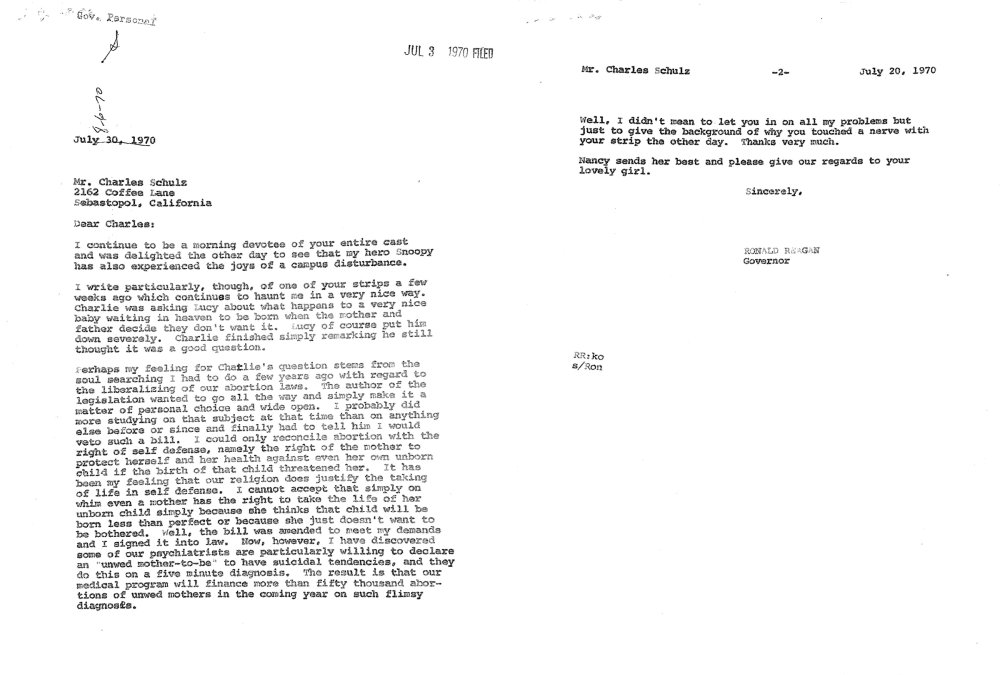
The strip Reagan was commenting on. (It was published on July 20, 1970).


by Reinhard Kargl
Commerce has tricked many people into believing that Christmas begins with Black Friday sales.
Of course, nothing could be further from the truth. The four weeks before Christmas are called “Advent”. Thereafter, Christmas begins with Holy Night (the night from December 24th to December 25th). Or does it?
Well, if you really love Christmas, you may actually enjoy it three (or even four) times. How come?
First of all, there are no historical records of the birth date of Jesus of Nazareth. So the chosen date for celebrating the birth of Jesus Christ was picked rather arbitrarily. However, it stands to reason that the date was chosen to coincide (roughly) with winter solstice. This natural event had been a sacred day ever since human civilization grasped the rudimentary fundamentals of celestial cycles. The Romans (as well as many other literate cultures) had of course more than just a basic understanding of this.
By the way, contrary to popular belief, Christmas is not the most important holiday in Christianity, nor was it even celebrated in the early beginnings.
In 330 AD, the Roman Empire split into two parts: the western half centered in Rome, and the eastern half centered in Constantinople. The churches of the Western Roman Empire continued to celebrate Christmas as a minor holiday on December 25.

But in the East, the birth of Jesus began to be celebrated in connection with the Epiphany, on January 6. This holiday was not primarily about the the birth of Jesus, but rather his baptism. The feast was introduced in Constantinople in 379, in Antioch towards the end of the fourth century ( probably in 388) and in Alexandria in the following century.
When it comes to marking days, all conventional, numerical calendar systems suffer from an astronomical problem: During the time it takes for the Earth to complete one full orbit around the Sun, our planet rotates 365.256 times around its own axis. What this means is that the day isn’t really 24 hours long. Earth spins once in about 24 hours with respect to the Sun, but once every 23 hours, 56 minutes, and 4 seconds with respect to other, distant, stars.
So one Earth year isn’t 365 days long, but precisely 365 days, 5 hours, 48 minutes and 46 seconds. How does one put that into a calendar when we define each 24-hour period as a “day”? And when we divide the year into 12 months – which, by the way, are all arbitrary, man-made definitions? There really are are only four natural demarkations in the year that play a major role in our lives: the two equinoxes and the two solstices, which mark the beginnings of each season.
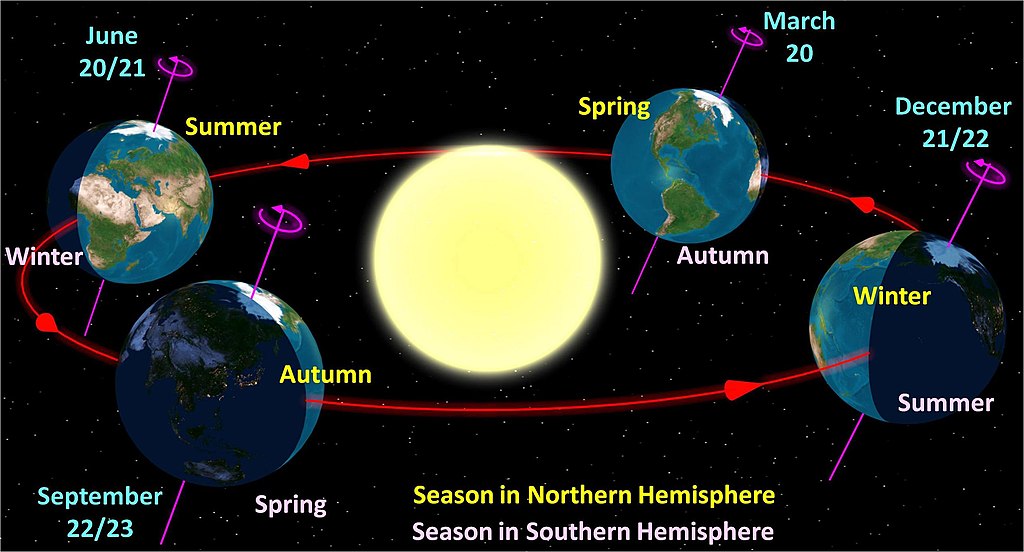
For completeness, because Earth’s orbit isn’t a circle but an ellipsis, there are the two apsides, the two extreme points of Earth distance to the Sun: Aphelion (apoapsis) and perihelion (periapsis). But these two would have little to no practical effect except for those studying such things.

The Julian Calendar, was proposed by Julius Caesar in 46 BC and enacted by edict on January 1, 45 BC. No, Julius did’t invent it. It was a reform of an earlier Roman calendar and probably designed by Greek mathematicians and Greek astronomers such as Sosigenes of Alexandria.
Whoever did it, the Julian Calendar was undoubtedly one of mankind’s most remarkable intellectual accomplishments. But as all human explanations of natural phenomena, it is rather imperfect in that although its synchronization with the solar year is better than most other calendars, the deviations get bigger and bigger as time goes on. Eventually, the year’s four seasons and the calendar will become way off.
One can correct these deviations from the natural world by throwing in “leap time” – a strange concept in which we are basically making up days, months or even years. (In other words, we are violating the rules of science by purposely making our interpretation of the reality fit the observation).
In order to reduce the need for such calendar doctoring, Pope Gregory XIII in October 1582 introduced the Gregorian calendar as a correction of the Julian calendar.

This has liturgical significance since calculation of the date of Easter assumes that spring equinox in the Northern Hemisphere occurs on March. To correct the accumulated error, Pope Gregory ordained the date be advanced by ten days. (One can do that is one is pope).

Most Roman Catholic lands adopted the new calendar immediately. (Not that they had much of a choice). The clerical leaders of Protestant lands who did not recognize the pope’s authority of course protested. But eventually, they too ended up following suit over the following 200 years. (Not because Protestants admitted the pope’s new calendar was a good innovation, but because having two different calendars caused quite a bit of confusion. Let’s just say it wasn’t popular with the masses).
The British Empire (including the American colonies) adopted the Gregorian Calendar in 1752 with the Calendar (New Style) Act 1750. At that time, the divergence between the two systems had grown to eleven days.
This meant that Christmas Day on December 25 (“New Style”) was eleven days earlier than it would have been but for the Act, making “Old Christmas” (“Old Style”) on December 25 happen on January 5 (“New Style”).
In February 1800, the Julian calendar had yet another leap year but the Gregorian calendar did not. This moved Old Christmas to 6 January (“New Style”), which coincided with the Feast of the Epiphany.
For this reason, in some parts of the world, the Feast of the Epiphany, which is traditionally observed on 6 January, is sometimes referred to as “Old Christmas” or “Old Christmas Day”.
So where do we stand today? According to the Gregorian calendar, Western Christianity and part of the Eastern churches celebrate Christmas on December 25.
The Armenian Apostolic Church, the Armenian Evangelical Church, and some Anabaptists (such as the Amish people) still celebrate “Old Christmas Day” on January 6.
Meanwhile, most Oriental Orthodox and part of the Eastern Orthodox churches celebrate on January 7 (which corresponds to “Old Style” December 25).
Lastly, the Armenian Patriarchate of Jerusalem maintains the traditional Armenian custom of celebrating the birth of Christ on the same day as Theophany (January 6), but it uses the Julian calendar for the determination of that date. As a result, this church celebrates “Christmas” (actually, Theophany) on what the majority of the world now considers to be January 19 on its Gregorian calendar.

So there you have it! The dates of Christmas are neither prescribed by God nor nature, but by man. They are nothing but human convention, and they differ because of the problems inherent in making a calendar that accurately reflects nature, along with some religious differences. Celebrate as you wish!
Merry Christmas.
This will be the second full moon in October 2020, making it a so-called rare “Blue Moon”. Not only has there not been a full moon on All Hallow’s Eve since 2001, there won’t be another one until 2039. And for the first time tonight’s Blue Moon will be visible to most of the world in 75 years.
You will also see a red object near the moon tonight: that’s Mars. Also happening on Saturday night: Asteroid 2020 UX3 will be whizzing by Earth at a speed of 36,000 miles per hour. But don’t worry – experts who track this sort of stuff say it won’t hit us. But there’s another asteroid (2018VP1) making a close pass by Earth on Election Day.
Spooked yet?

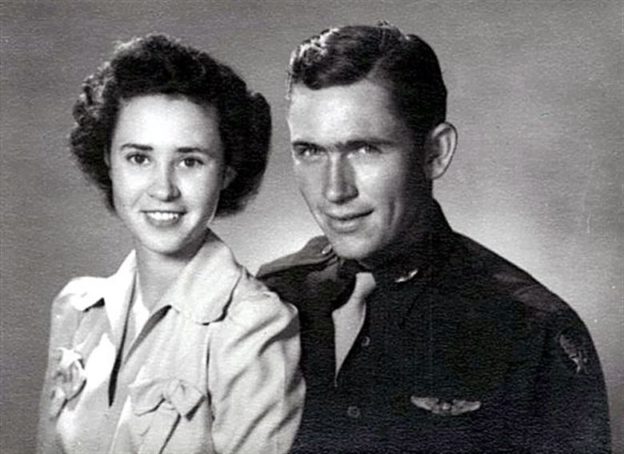
Peggy S. Harris and 1st Lt. Billie D. Harris were married for just six weeks before Harris deployed in World War II. His wife never saw him again. His plane was shot down and crashed into the woods near a small town in Normandy. It took Peggy 60 years to find his grave.
For many of us, the coronavirus shutdowns mean being separated from loved ones, and most of us are longing for a return to the social activities we once enjoyed.
But our inconveniences and hardships pale by comparison to the ordeals faced by those whose relationships were torn apart by war. Since 1775, the U.S. has lost 1.36 million of its people to warfare. And while the vast majority were young men, most of them left behind family, a lover, a fiancé, or a wife and children.
Here are a few snippets of wartime correspondence bearing testimony of the sacrifices made.
At the age of 23, Frank M. Elliott left Georgetown University to join the U.S. Army in 1943. From England, he writes to his wife:
May 6, 1944
Dearest Darling,All day I have been fighting the feeling which has been dominating me of late. I keep continually thinking of home and longing for home in the worst way. All your letters of how beautiful my daughter is becoming by the day. The realization that I am missing all these months and years of her formative growth is actually gnawing at my heart. . . .
I love you, Frank
Pauline “Polly” Elliott, 24, answers from the couple’s home in New Castle, Pennsylvania. They had a little daughter, DeRonda “Dee”.
May 28, 1944
Darling—
Here it is Sunday again — Sunday night. I think this is the most lonely time of the whole week for me. I am so darn lonesome for you, Frank darling. Oh I’m not the only one and I know it — there are millions just like me, wishing with all the strength of their hearts and minds for the return of peace and loved ones. — Dee is sleeping on this Sunday night, and the radio is playing old and beautiful music — and I am thinking of the Sunday nights to come when you will be listening to such music with me. — Took Dad to a ball game today — Dee went along — maybe she’ll learn to like baseball as well as her Daddy does — I’ll bet that she will.
I adore you, Polly
A week later, she writes to him:
June 5, 1944
Darling,
. . This is a beautiful summer evening, darling. I am sitting at the kitchen table (and not even noticing the noise of the refrigerator) from which place by merely lifting my head and looking out the window I can gaze upon a truly silvery, full moon. It’s beautiful, dear — really beautiful, and it has succeeded in making me very sentimental. I had begun to think that I was becoming immune to the moon’s enchantment — so often I have looked at it without you and to keep myself from going mad told myself “It’s pretty, yes — but, so what?”. . . That’s not the way it really is though, darling — the sight of that shining moon up there — the moon that shines on you, too — fills me with romance — ; and even though it’s just a dream now, it’s a promise of a glorious future with one I love more than life. The darned old moon keeps shining for us, darling — and even as it now increases that inescapable loneliness, it also increases my confidence in the future. I truly love you . . .
Frank M. Elliott was killed the next day, June 6, 1944 (D-Day).
Here’s a letter written by a girl from Boston:
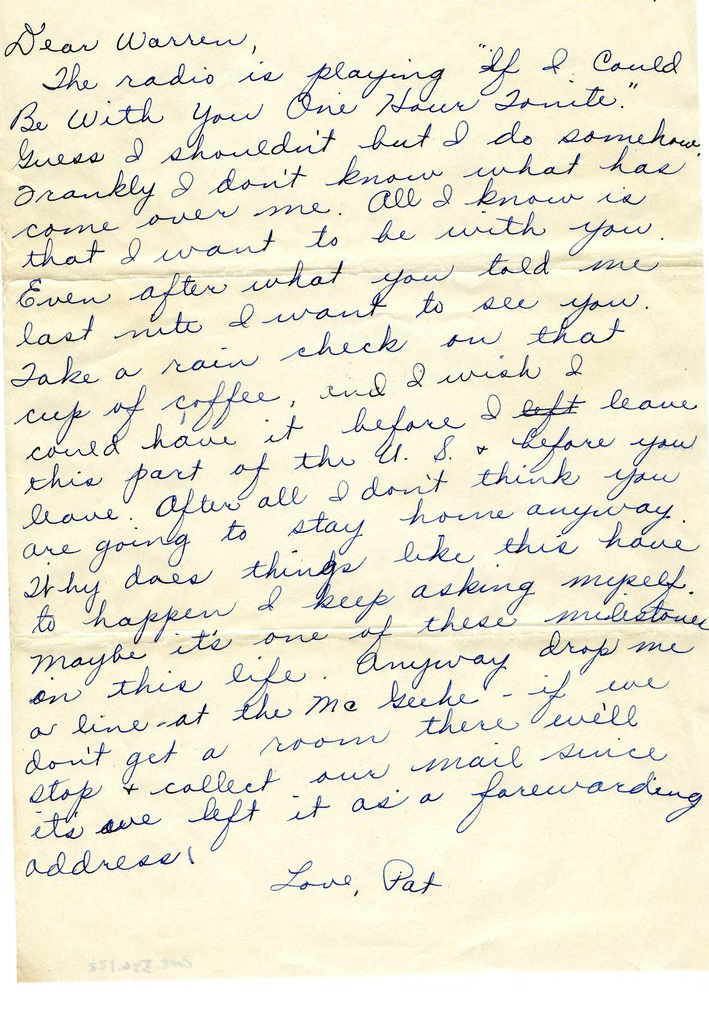
A letter from Barth, Germany, dated May 10, 1945:
Sweetheart,
At last I can write you and say just what I please. I don’t know whether this will reach you before I get home, but it’s worth taking the chance. You cannot realize the joy I have experienced at being liberated, and the prospects of being with you soon. The Germans pulled out of here on April 30th, and we took over. The Russians arrived on May 2. Since then we have been impatiently waiting to get out of here…
…It has been a long time and you have not been out of my thoughts for one minute. I’ll close now, sweetheart, hoping and praying that we will be together very soon for all time. I love you with all my heart.
Your loving husband,
Arnold
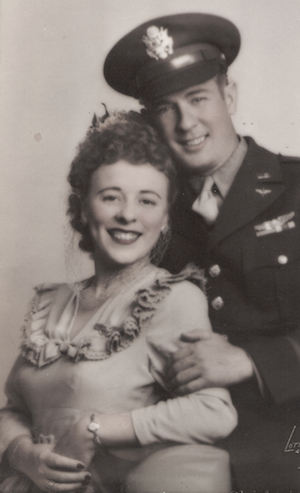
Lieutenant Arnold L. Gray and Hazel J. Gray were reunited and lived a happy life after the war.
Here’s an excerpt from a letter written by 23-year-old Lt. Richard G. Fowler, a U.S. Army Air Forces navigator from Minnesota, to his wife Cornelia.
May 25, 1944
My darling Cornie —
This is my first letter to you in almost five weeks! And I’m writing it not knowing when I’ll be able to mail it, since believe it or not, I’m behind enemy lines.
Fowler’s B-24 bomber had been shot down over the Balkans. 8 crewmen where killed, but Fowler and another man were able to bail out on parachutes.
When I was certain the chute was open, I looked up and saw the white silk billowing and swaying in the wind. It was very quiet and you have no sensation of falling until you near the ground—just floating in space. My face and right hand had been burned quite badly and hurt like the very devil. A thousand thoughts ran through my head as I was falling. It took about ten minutes before I hit the ground so I did have time to think. First of all I wondered what you would think not hearing from me for a long time—I was quite certain I would be captured by the Germans and taken to a prison camp in Germany.
Lt. Fowler survived the war and was eventually reunited with his wife. Many other families were not so lucky:
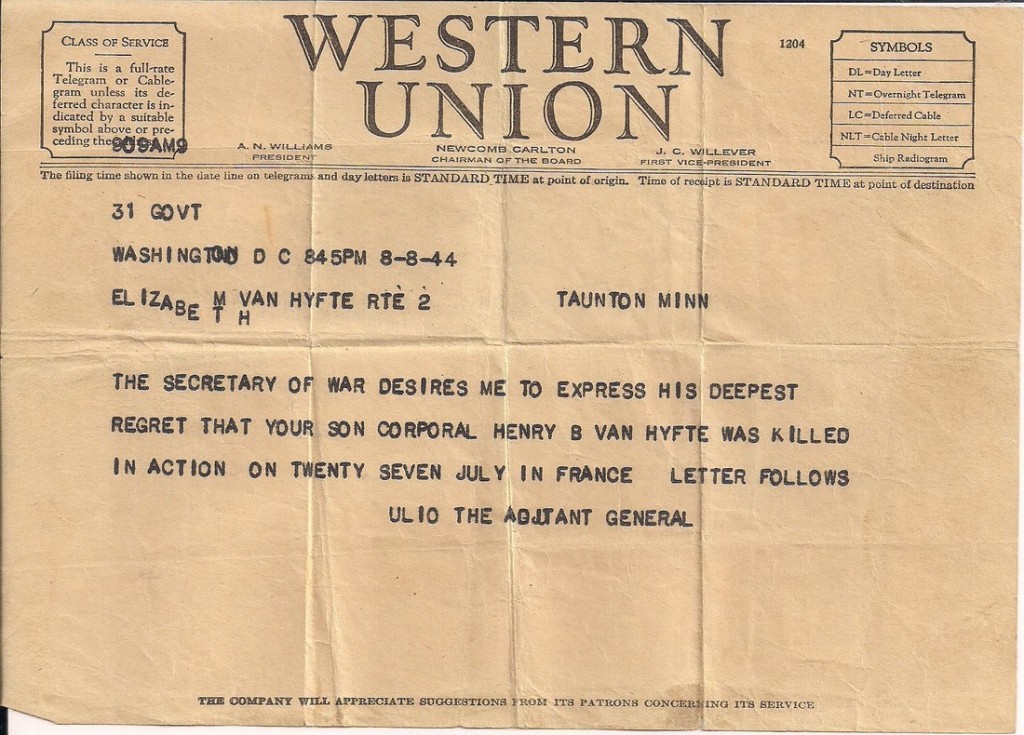
This Memorial Day, let’s also consider those whose hopes for love and happiness were crushed and destroyed when war took the love of their life, never to return, leaving behind a void never to be filled.
– 30 –
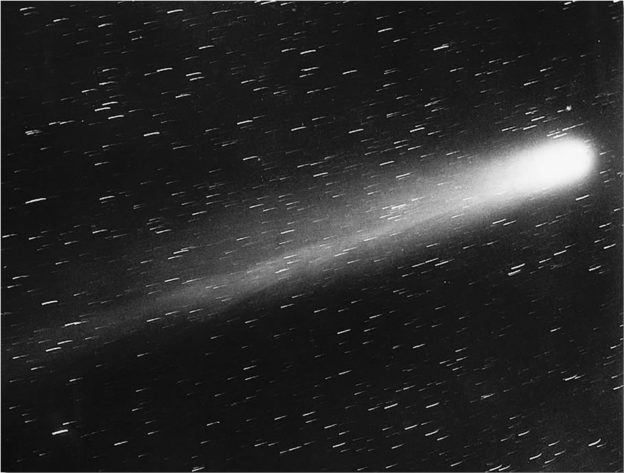
by Reinhard Kargl
On May 19 / May 20, 1910, Earth passed through the tail of Halley’s Comet with great fanfare.
The event is meaningful to me for two reasons. First, my grandmother told me about it when I was little. She herself was a little girl in 1910, and her memories were not very detailed. But she recalled, as her strongest memory, the general feeling of excitement among the adults around her. Some must have been genuinely panicked, others were probably nervous, and yet others were mocking those who suffered from vivid superstitions.
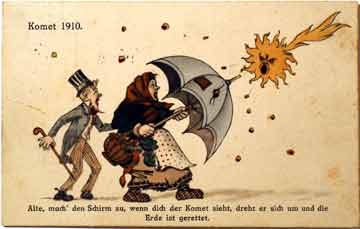
Today, few people know that there was actually another comet visible in the sky earlier that year of 1910. The “Great January Comet of 1910”, officially designated “C/1910 A1” was a surprise visitor in the sky. Already visible to the naked eye when it was first reported on January 12, it brightened very suddenly, to the point where it eventually became brighter than Venus, and was visible during the day.
First spotted in the southern hemisphere, it reached perihelion on January 17 with a magnitude of –5. It then declined in brightness but became a spectacular sight from the northern hemisphere in the evening twilight. By early February, its curved tail reached 50 degrees into the sky.
There were of course plenty of newspaper accounts. The public, not yet accustomed to front page astronomical news, became highly interested in comets, and in what the experts had to say — especially at a time when superstitions and the belief in metaphysics was much more widespread than today.
At the time, Halley’s Comet, which had been known since ancient times, had been calculated to reach its perihelion on April 20, based on Newtonian physics and the work of Edmond Halley.
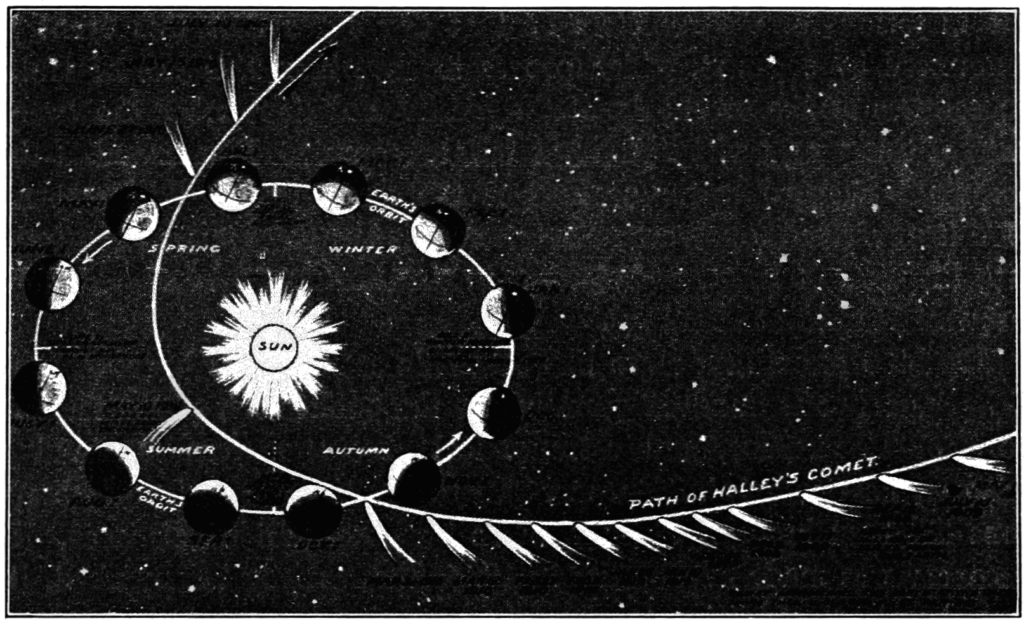
Astrophotography and astrospectography were new fields, they were used to detect toxic gas cyanogen gas in the comet’s tail. The highly famous French astronomer and author Nicolas Camille Flammarion speculated that, when Earth passed through the tail, the poison gas “would impregnate the atmosphere and possibly snuff out all life on the planet.”
Flammarion was not only a genius scientist and author, but also a man with rather esoteric beliefs. He believed not only in the transmigration of souls, but also in telepathy, apparitions, hauntings, and “psychic forces”.
Very quickly, all manner of profiteers, charlatans, mystics, and those purporting to possess special astrological insights, seized on the opportunity, and soon, the panicked public was buying up quack “anti-comet pills”, “anti-comet umbrellas” and gas masks. Sadly, we even find newspaper accounts of people committing suicide because they didn’t want to see the catastrophe.
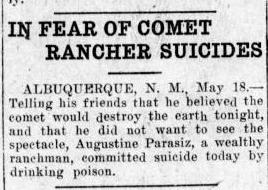
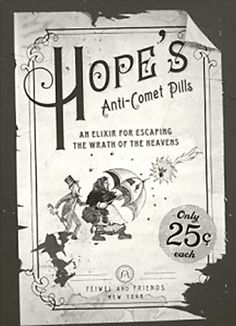
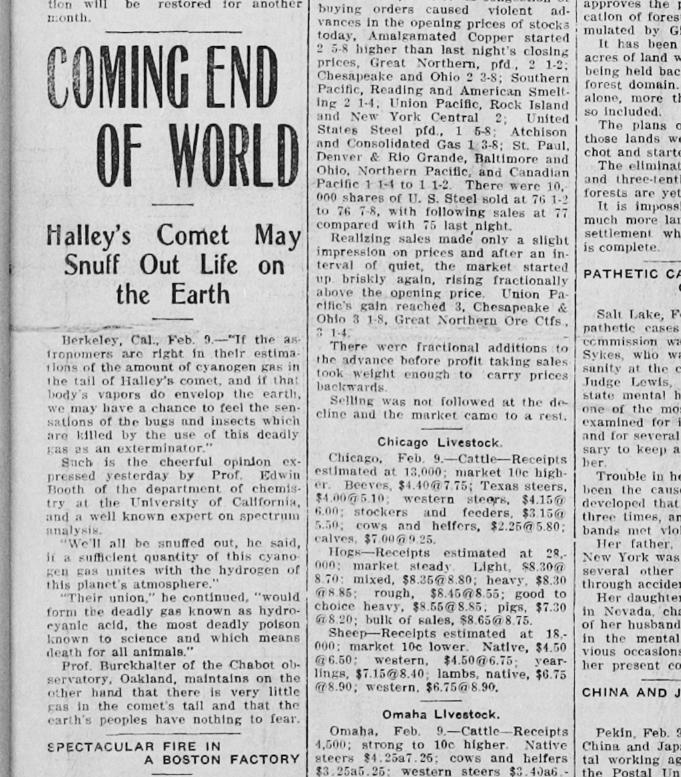
Considering the nature of what left the strongest impression in my grandmother’s memories, I wonder what today’s small children will remember, many decades from now, about the current COVID-19 crisis. Surely, it will be memories about how we adults reacted, which should also give us reason for contemplation.
The other reason why Halley’s Comet interests me is its association with one of my favorite authors and personalities. Mark Twain was born November 30, 1835, exactly two weeks after the comet’s previous perihelion. In his autobiography of 1908, he writes:
I came in with Halley’s comet in 1835. It is coming again next year, and I expect to go out with it. It will be the greatest disappointment of my life if I don’t go out with Halley’s comet. The Almighty has said, no doubt: ‘Now here are these two unaccountable freaks; they came in together, they must go out together.’
Twain died on 21 April 1910, the day following the comet’s subsequent perihelion. This is how the comet looked that day:
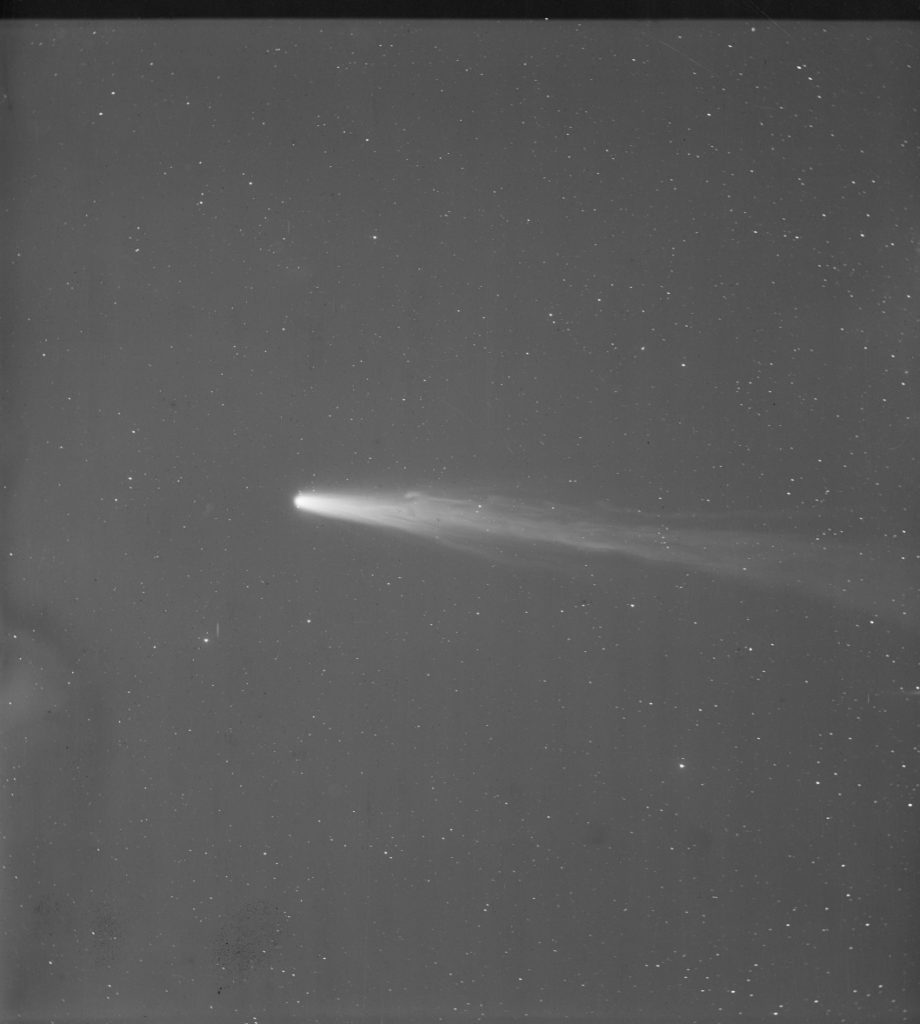
– 30 –
by Reinhard Kargl
In online forums, people frequently ask if traditional oils such as 3-In-One (or gun oils such as Hoppe’s No. 9) are a good choice for use on pocket knives. Here’s my answer, based on some history and science behind it.

3-In-One oil was first sold in 1894. It was originally marketed for use on bicycles and bicycle chains. Over generations, it grew into a quintessential American product used on just about any moving metal parts imaginable – including millions of folding knives. Even today, many people still swear by it. It performs its main function (that of lubrication) very well, is widely and easily available, and costs only a fraction of fancy modern high-tech lubricants. (I might add that traditionalists often deride the latest lubricants as overpriced, overhyped snake oils). But is it the best option?
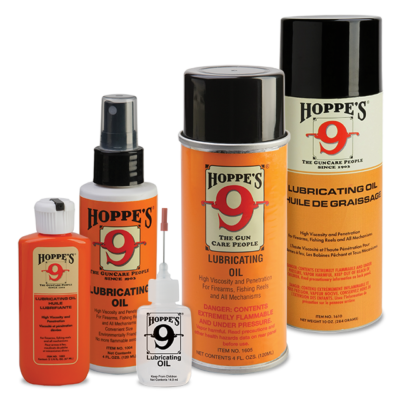
Old-school gun oils, such as Hoppe’s No. 9 or others, also lubricate very well (or even better) than 3-In-One. But all of these products have something in common: they were all formulated at a time when high-carbon steels were the norm for guns, knives and moving parts in machinery. These steels rust when coming into contact with oxygen, especially so in the presence of water. Therefore, old time lubricants include compounds meant to “stick” to the steel and isolating it from oxygen and water as much as possible. As other, shorter-chained hydrocarbons evaporate over time, a higher percentage of the longer-chained, more viscous compounds remain. In addition, all oils will eventually undergo chemical changes. They will also pick up dust and debris. All of this combines to make them more gummy, grimy, dry or gritty over a period of time.
Is this a problem in an application like folding pocket knives? Not really, but it depends. I believe the criticism of oils like gun oils and 3-In-One is mostly based on user error and therefore undeserved. What happened is that collectors have dabbed these oils on, and then put away their treasures without really using them for long periods of time. Surprise surprise: the moving parts became awfully sticky. And since collectors tend to be accepted as authorities and opinion leaders by the general public, negative assessments of traditional oils became blown out of proportion.
That’s not really a problem for the every day user who follows a simple rule of maintenance: Don’t just oil you pocket knife and put it away. Whether you do or don’t use it, clean the old lubricant off from time to time. Do this in regular intervals or before it comes gunky. Use some type of solvent (maybe just soapy water and an old but clean toothbrush perhaps). Then rinse and dry thoroughly, and apply fresh lubricant.
Another point to consider is the steel from which your pocket knife is made. The vast majority of today’s pocket knives are made from a number of types of stainless steels. Since these do not require the level of corrosion protection needed for older high carbon steels, why would you need the more problematic compounds included in old-school oils? For something like a Victorinox Swiss Army Knife (Ibach, Switzerland), or the products of Buck Knives (Post Falls, Idaho) – you probably don’t.
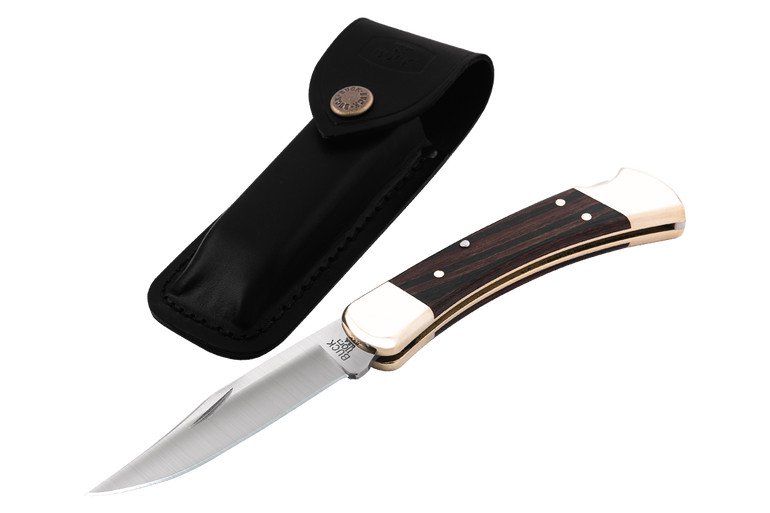
Another problem that may or may not concern you: 3-In-One oil and gun oils are not rated as harmless for human consumption. (That’s true for all petroleum-derived oils, with pure food grade mineral oil being the only commercially available exception I’m aware of). Does that matter? I doubt it, given the very small amounts of oil that might end up into your food. After all, you are not going to simmer your entire folding knife in your soup pot. (Hopefully). However, some of these oils may have a smell that could be unappetizing when you eat.

If you are concerned about toxicity, the old-school Ballistol, would be a non-toxic, extremely capable option. (I still would not recommend pouring it over your salad). Ballistol is the stuff of legend too numerous to recount here. It predates World War-I and has many highly compelling qualities. Among them are the very high stability and anti-corrosion properties, even on high carbon steel, and at great temperature ranges. Curiously, Ballistol emulsifies quite easily with water, which makes it even more slippery when it gets wet. German makers of carbon steel blades (for instance, OTTER-Messer of Solingen, Germany) actually recommend Ballistol to lubricate and inhibit rust on old-fashioned, high-carbon steel knives. They have even been known to ship some of their carbon-blades with a sealed Ballistol-soaked pad). Ballistol has a great number of uses around the house, which makes it a great, universal all-round product to keep around. The only downsides here: Ballistol has a mild but distinct sweet licorice-like scent, which some people find unpleasant. Conversely, other people love it. Another possible downside: it’s not very widely available. Then again, it is easy to order online these days.
If you are concerned about both toxicity and scent, the aforementioned food grade mineral oil would be an odorless alternative. A natural and plant based choice would be pure jojoba oil or “wax”, which comes from the seeds of Simmondsia chinensis, of a shrub of the North American Southwest. Refined jojoba oil is both colorless to slightly yellowish, and odorless. Yes, you could technically ingest it. But since our digestive system can’t break it down, it will basically function as laxative. (Even for that, it is not recommended).
Jojoba oil was reportedly used to lubricate machine guns in the past, probably because it is much more heat resistant than petroleum based old-school gun oils. A low percentage of triglycerides makes jojoba oil much more stable than other plant oils such as olive, grape seed, safflower, canola or almond oil. (Don’t put those in the moving parts of your folding knives. The same goes for animal fats such as butter or lard). Much cheaper than jojoba oil and available just about anywhere nowadays would be coconut oil. This one you can really eat. (If you have a high carbon blade used on food, it makes a good option for coating the blade, but not so much for the joints of a folding knife).
All that said, it must be remembered that none of these plant oils are nearly as stable as synthetic petroleum based oils or unique products like Ballistol. Also, the corrosion protection and lubrication capabilities of plant based oils in all temperature and humidity conditions are generally inferior to man-made lubricants – so beware.
Regardless of what kind of lubricant you use, my main recommendation is this: clean it off from time to time and apply fresh lubricant. Think of it as giving your pocket knife a regular oil change.
Bonus tip: If you use your knife to cut food (especially acidic things, like fruit), wipe it clean with a moist cloth immediately when the job is done. Then wipe it dry right away. (Even stainless steel isn’t totally “rust free”). And should you have a high carbon steel blade, rub on a little oil or fat. Don’t overthink this. Whatever kind of fat you have at hand will suffice. (Well, perhaps except salted butter). Sure, your carbon steel blade will discolor and form a “patina”, but that’s part of the fascinating aspects of carbon steel: no two blades will ever be the same – appealing to some, but not to others. Take it or leave it!
It is impossible to understand and appreciate a gothic cathedral without experiencing it in person. That is why, for nine centuries, millions people from all over the world have gone to Notre-Dame. Not anymore. This is endlessly horrific — not just for Paris, and not just for France, but for all mankind.
